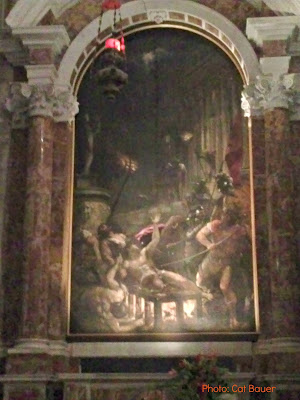 |
| The Martydom of St. Lawrence by Titian (1548-59) |
On Thursday, December 12, 2013, the altarpiece was presented in all its glory back home here in Venice in the newly-restored St. Lawrence Chapel inside the church of Santa Maria Assunta (called "I Gesuiti"). The funding to restore the painting itself came from the Bank of Alba -- St. Lawrence happens to be the patron saint of the Piedmont town. After a year-long restoration by Nicola Restauri S.r.l. di Aramengo, closely supervised by the Superintendence of Venice, the altarpiece was then on display in Alba from May 2012. The painting came back to Venice for a brief show at the Accademia (December 21, 2012 to February 24, 2013), then moved to Rome for the Titian extravaganza (March 5 to June 16, 2013) where the 15-foot high painting held a place of honor -- C.F. Villa said it would be worth going to the exhibition just to see the St. Lawrence. So, the painting has been on the road for more than two years, and is finally back home in its freshly spruced-up chapel.
 |
| Photo: Venetian Heritage |
 |
| Photo: Venetian Heritage |
I have read in several places that Titian painted the Martyrdom of St. Lawrence specifically for the St. Lawrence Chapel in the Church of the Gesuiti. This is not true. Titian was born in about 1485 and died in 1576; it took him more than ten years to paint the St. Lawrence (1548-59) for the funeral chapel of Lorenzo Massolo in the original Church of the Crociferi.
Ignazio di Loyola, the founder of the Jesuits, first came to Venice in 1523 on his way to Jerusalem. He returned to Venice in 1535 with a group of friends, and it was here in the lagoon that the Jesuits -- the Soldiers of God -- were ordained priests. Loyola died in 1556 at the age of 64.
The Jesuits did not acquire the Church of Santa Maria Assunta until 1657, after the Order of the Crucifers, who built the original church in 1155, were suppressed. (The Jesuits themselves have been expelled from Venice on more than one occasion.) Work to redo the church in the ornate fashion we see today began in 1715; the church was consecrated in 1728. So, it was the Jesuits who were responsible for the ornate decoration, which was paid for by the Manin family, whose tombs are inside, and whose coat of arms is over the door. And it was the Jesuits who relocated Titian's The Martyrdom of St. Lawrence into the first chapel on the left in new church in the 18th century.
 |
| Photo: Venetian Heritage |
According to Nick Squires at The Telegraph, the restoration revealed that Titian, wily artist that he was, painted himself into the scene wearing a turban, apparently to attract the charms of Elisabetta Querini, the wife of one of his patrons.
Marco Loredan, a descendent of one of Venice's oldest families, was at the presentation on behalf of his brother, Francesco, who is an advisor for Fondazione Venetian Heritage Onlus and was unable to attend, and -- more importantly -- because the Martyrdom of St. Lawrence is Marco's favorite Titian -- he is passionate about the painting. Marco is a great ambassador for his city; he really loves Venice, and is a true gentleman. We both agreed that Titian was centuries ahead of his time, and that the restoration was brilliant -- before, the painting had been nearly black.
After the presentation we stepped outside into the dreamy Venetian mist and proclaimed that Venice remains the most magical city on earth.
Cat
Venetian Cat - The Venice Blog




Titian is my all-time favorite artist, and the Martirio di San Lorenzo, now estimated to be worth 50 million euros, was called “the most beautiful night scene in all of painting" by Giovanni C.F. Villa, curator of the spectacular Titian exhibit this past spring at the Quirinal Palace’s scuderie in Rome.
ReplyDeleteWonderful paintings in this great city. Can't wait to visit it at the end of the year. Bought the ticket already on flysky.ro and I am now preparing for the departure:)
ReplyDelete